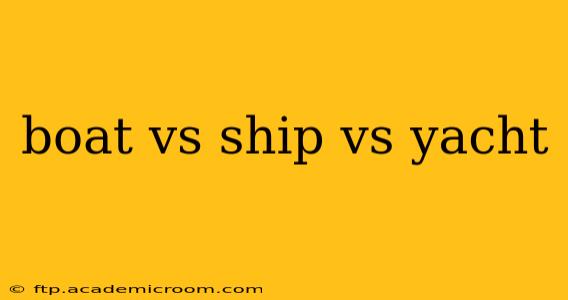The terms "boat," "ship," and "yacht" are often used interchangeably, leading to confusion. While they all refer to watercraft, there are distinct differences based on size, purpose, and design. This comprehensive guide will clarify the nuances between these three nautical terms, answering common questions and providing a deeper understanding of their classifications.
What is the difference between a boat and a ship?
The primary distinction between a boat and a ship lies in their size and construction. While there's no universally agreed-upon size threshold, a ship is generally considered a larger, more complex vessel designed for commercial or military purposes. Ships often have multiple decks, specialized compartments, and a larger crew. They're built for transporting cargo, passengers, or deploying military assets. Think of massive cargo ships, cruise liners, or aircraft carriers – these are all ships.
A boat, on the other hand, is typically smaller and simpler, often used for recreational purposes or smaller-scale commercial activities like fishing or transporting goods on a smaller scale. Boats can range from small dinghies to larger motorboats, but generally lack the complexity and size of a ship.
The crucial distinction is less about a specific length and more about the vessel's function and design. A small, but complex, research vessel might be considered a ship despite being smaller than some large pleasure boats.
What is a yacht?
A yacht is a type of boat, specifically a pleasure boat of substantial size and luxury. While there's no strict definition on size, yachts are generally larger and more opulent than typical recreational boats. They're designed for leisure activities like cruising, racing, or simply enjoying the water in style and comfort. Yachts often feature lavish amenities like spacious cabins, gourmet kitchens, and entertainment systems. Think of elegant sailboats, fast motor yachts, or mega-yachts – these exemplify the category. The key is the emphasis on luxury and recreational use.
What is the difference between a ship and a yacht?
The difference between a ship and a yacht is primarily one of purpose and luxury. A ship is built for commercial or military function – cargo transport, passenger transport, or naval operations. A yacht, while potentially large, is primarily designed for pleasure and recreation. A mega-yacht might be as large or even larger than some smaller ships, but its purpose is distinctly different.
What types of boats are there?
There are numerous types of boats, categorized by various factors such as their propulsion, hull design, and intended use. Some common examples include:
- Sailboats: Propelled by wind power using sails.
- Motorboats: Powered by engines.
- Fishing boats: Designed for commercial or recreational fishing.
- Rowboats: Propelled using oars.
- Canoes & Kayaks: Small, lightweight boats propelled by paddles.
What are the different types of ships?
Ships are similarly diverse, with categories including:
- Cargo ships: Transport goods across waterways.
- Cruise ships: Carry passengers on leisure voyages.
- Tankers: Carry liquids like oil or chemicals.
- Container ships: Transport goods in standardized containers.
- Military ships: Used for defense and naval operations.
Are there different types of yachts?
Yachts exhibit considerable diversity as well, with common types being:
- Sailing yachts: Rely on sails for propulsion.
- Motor yachts: Powered by engines.
- Mega-yachts: Exceptionally large and luxurious yachts.
- Sportfishing yachts: Designed for both recreational cruising and serious fishing.
How are boats, ships, and yachts classified?
Classification is based on a combination of factors – size, construction, purpose, and features. Size isn't the sole determinant; a small, highly specialized research vessel might be classified as a ship, while a large luxury powerboat is undoubtedly a yacht. Purpose and the level of luxury and comfort are key differentiating factors.
In conclusion, understanding the differences between boats, ships, and yachts hinges on recognizing their primary functions and levels of luxury. While size can be a general indicator, the intended use and overall design are more definitive factors in classifying these watercraft.
